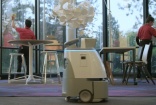Home › magazine › special features › Robotic solutions and AI robots in real life
Robotic solutions and AI - robots in real life
5th of August 2024Autonomous cleaning robots are becoming a viable solution for certain applications and requirements, especially where speed is a priority or there is a need for a quiet and inobtrusive cleaning function. The technology may still be in its infancy, but with increasing experience there is growing understanding with regards to where value can be added and how it can support physical cleaning teams. Steven Foster, CEO at OMNI Group, tells us how this company is integrating latest technologies.
We have spent the past 18 months – investing considerable time and resources – challenging the perception that this smart technology does not yet have a compelling business case for commercial cleaning applications. This is enabling us to embrace the latest advances in robotics within our fully managed outsourced hotel cleaning operation, identifying viable applications in hotel rooms, corridors and open spaces such as receptions, dining, bar and event areas.
Our success has been underpinned by extensive equipment testing and live trials to establish viable applications, calculate return on investment and identify where robotics can support its physical teams. Like many service providers in the cleaning sector there was some initial scepticism, but the results have genuinely impressed us. By demonstrating proof of concept, across multiple machines, it is allowing us to truly commit to the technology and transform our cleaning operation, working closely with our customers and teams to deliver measurable value.
The technology surprised us in a couple of ways after the trial phase. Firstly, team members were very quick to tell us the robots made their jobs easier, which is such a bonus when employee buy-in is crucial for any successful roll-out. And secondly, the quality and consistency of cleaning was remarkable and better than anything we were expecting. So much so that we wrongly assumed the team had completed a carpet shampoo when inspecting the results after the three-month trial.
One of the biggest contributors to dust in a bedroom or corridor comes from occupied dust that sits under the fibres, which then kicks up when the carpet is walked on. Even when manually vacuumed this dust usually remains and then is often found collecting on skirting boards and picture frames. This was not the case when using robots and almost all occupied dust was removed, while a HEPA filter cleaned the air.
The team liked it, and the quality was certainly there, so then it became about cost – how does a customer afford the machine? What is the return on investment? We evaluated how long a team member would take, while also considering that the robots clean a much greater proportion of the available floor space compared to a manual vacuuming.
At a bigger hotel you may need a dedicated member of staff just to clean the corridors, so we quickly identified a viable function. For one 1,100-room hotel, we were able to alleviate a serious recruitment challenge by using robots to handle autonomous vacuuming in all corridors and reduce the burden on our team there. For smaller sites, we found that room attendants would typically only spend 20 seconds vacuuming outside a room and mainly focusing on the things they can see, so there was huge potential for quality improvements.
These robots have proven to be highly effective in larger, open spaces, saving over two hours of physical cleaning time per 500 square metres, even operating safely and discreetly while these public areas are still in use. They deliver a consistent level of performance, with HEPA filters to improve air quality, while providing a deeper level of cleaning than is achievable with most vacuum cleaners to better protect the carpets. Working alongside a physical team, the machines clean almost 100 per cent of the available space.
As part of the set-up process the space is mapped out, so the robot can get to work and autonomously and independently complete the desired cleaning task. This is particularly useful after events that run until late because the machines can be set-up to operate overnight, rather than a physical team needing to stay behind to work during the early hours of the morning. Should any issues occur the robot can automatically alert the night team.
We have since evaluated a significant number of robots and introduced three so far to our operation. This includes an in-room solution that can also be used in smaller event spaces, bar areas and corridors. What you initially notice is the cleaning quality, but alongside this we are seeing productivity savings improving all the time. We work closely with our manufacturing partners, and regular software updates are helping the machines to cover more space, move quicker and eliminate re-vacuuming areas.
The in-room robot works alongside the room attendant to increase how many bedrooms are cleaned. We are already achieving an average of 8-10 minutes to vacuum a single bedroom, with a productivity improvement of up to 12.5 per cent per shift. The machine maps out the room and then cleans the maximum available space – typically 80 per cent to 90 per cent of a room – returning to its starting point and shutting down ready for emptying and moving to the next space. In contrast, a human operative will only clean what they see.
Meanwhile, we have undertaken a trial at one site using a robot to clean and maintain a range of hard floors in a reception area, including marble, hard gloss porcelain and ceramic tiles. The results have been dramatic, achieving a 50 per cent cut in costs, while reducing the frequency of diamond cutting to polish marble floors from three times a week to once every two weeks with zero quality change. This fully automated machine starts, ends, and empties itself, as well as refilling its water tank, providing a nightly deep clean without any human intervention.
Based simply on productivity savings achieved to date, we believe that return on investment can be achieved on all three machines within the first 12 months. However, for us it is more about addressing the recruitment gap rather than cutting jobs. The robots also remove tedious and laborious duties from our staffs’ roles, while freeing up time for higher value tasks.
The robots deliver improved levels of performance when compared to manual vacuuming and cleaning. As a result, hotel residents benefit from improved air quality, reduced dust and higher health and hygiene standards. And the hotel can also prolong the life of carpets and flooring.
For the best results, robotics needs to be closely aligned and integrated with existing processes, complementing the physical team to get the job completed in the most efficient way possible. The machines can be a very useful tool to improve performance but they are still a tool, and as such, need to be managed and operated correctly. Training is certainly required to ensure cleaners, supervisors and managers are handling and maintaining the robots correctly.
We are very aware that team members can feel threatened, so we communicate the change to reassure everyone the technology is designed to work in conjunction with them. Of course there are challenges to overcome, especially in the case of bedroom cleaning, because we are asking them to adapt their routine to incorporate the machines. However, once we get a team on board the feedback is always positive. Anecdotally, we have even heard the robots are helping to reduce back pain and other physical impact on our employees’ bodies.
The sophistication of robots is only going to improve, evolving to take advantage of emerging AI, tracking and cloud-based technology. Enhanced connectivity will bring together both human and robotic resources into a single management system, while advanced sensors will deliver greater levels of control, functionality and monitoring. Furthermore, scanning technology will eventually have the ability to identify cleaning requirements and maintenance defects in real-time or on-demand to support usage-based cleaning and maximise resources.
Our success has taken a huge amount of effort, persistence and clever thinking but it is already achieving a range of benefits including enhanced cleaning quality; improved staff wellbeing and morale; and increased workforce productivity.









